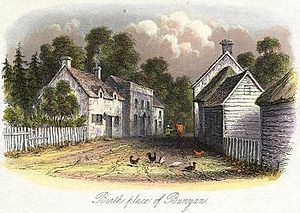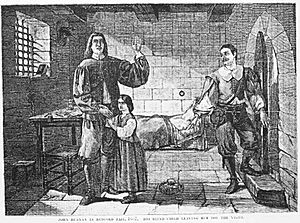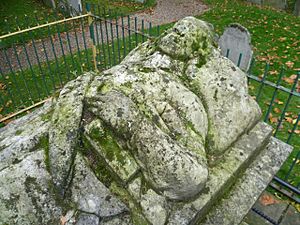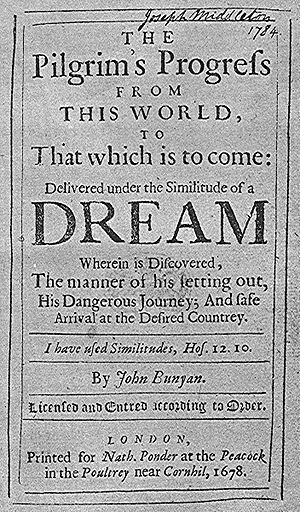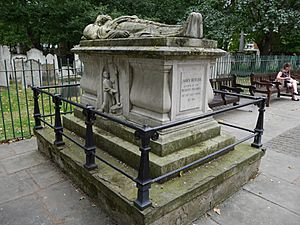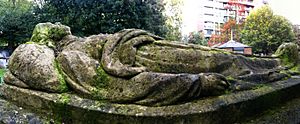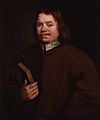John Bunyan facts for kids
Quick facts for kids
John Bunyan
|
|
|---|---|
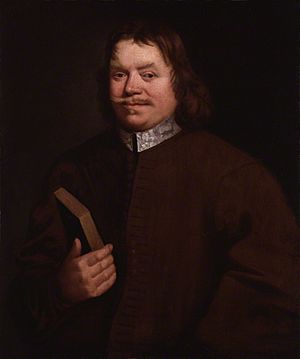 |
|
| Born | 1628; baptised 30 November 1628 Elstow, Bedfordshire, England |
| Died | 31 August 1688 (aged 59) London, England |
| Occupation | Writer and Puritan preacher |
| Genre | Christian allegory, sermons, Socratic dialogue, poetry |
| Notable works | The Pilgrim's Progress, The Life and Death of Mr. Badman, The Holy War |
| Signature | |
John Bunyan was a famous English writer and Puritan preacher. He was born in 1628 and passed away in 1688. He is best known for his Christian story The Pilgrim's Progress. This book became very important and influenced many other writers. Besides The Pilgrim's Progress, Bunyan wrote almost sixty other books. Many of these were longer versions of his sermons.
Bunyan grew up in the village of Elstow, near Bedford. He went to school for a while. At 16, he joined the Parliamentary Army during the English Civil War. After three years in the army, he went back to Elstow. He became a tinker, fixing pots and pans, a skill he learned from his father.
He became very interested in religion after he got married. He first went to the local church. Later, he joined a nonconformist group called the Bedford Meeting. This group met in St John's church in Bedford. Bunyan soon became a preacher.
When the king returned to power, nonconformists lost some of their freedom. Bunyan was arrested because he refused to stop preaching. He spent the next twelve years in prison. During this time, he wrote his spiritual autobiography, Grace Abounding to the Chief of Sinners. He also started writing his most famous book, The Pilgrim's Progress.
In 1676, the king changed his mind about religious freedom. Four years later, Bunyan was put in prison again. This time, he was only there for six months. During this second imprisonment, he finished The Pilgrim's Progress.
Bunyan's later years were more peaceful. He continued to be a popular writer and preacher. He was also the pastor of the Bedford Meeting. He died at age 59 after getting sick on a trip to London. He is buried in Bunhill Fields. The Pilgrim's Progress became one of the most printed books in English. By 1938, 250 years after his death, 1,300 different versions had been printed.
The Church of England remembers John Bunyan with a special day on August 30. Other churches, like the Anglican Church of Australia, honor him on the day he died, August 31.
Contents
John Bunyan's Early Life
Growing Up in Elstow
John Bunyan was born in 1628 in Elstow, Bedfordshire. His parents were Thomas and Margaret Bunyan. His exact birthday is not known, but he was baptized on November 30, 1628. The family name "Bunyan" was spelled in many ways. It likely came from a French name, Buignon. Bunyans had lived in Bedfordshire since at least 1199.
John's father was a brazier or tinker. He traveled around fixing pots and pans. John learned this trade from his father. He also went to school for some time. We don't know which school he attended. In his book Grace Abounding to the Chief of Sinners, Bunyan said his family was "meanest and most despised". However, his grandfather owned land, so his family was not as poor as he made it sound.
Bunyan wrote that he used to swear a lot, like his father. He also had nightmares and read popular storybooks. In 1644, when he was 16, his mother and sister Margaret died. That autumn, Bunyan joined the Parliamentary army. He was part of the army during the first part of the English Civil War. He was listed as a private soldier named "John Bunnian" in Newport Pagnell.
In Grace Abounding, he told a story from his army days. It showed him how lucky he was. He was supposed to go to a siege, but another soldier offered to go in his place. That soldier was shot and died while on duty.
Being in the army taught Bunyan about military language. He used this language in his book The Holy War. He also met people from different religious groups in Newport Pagnell. He admitted that he was "the very ringleader of all the Youth that kept me company, in all manner of vice and ungodliness" before he got married. Bunyan left the army in 1647. He returned to Elstow and continued his trade as a tinker. He moved to a cottage in Elstow High Street.
Marriage and Finding Faith
Within two years of leaving the army, Bunyan got married. We don't know his wife's name or the exact date. His wife was a religious young woman. She brought two books from her father into the marriage. These were Plain Man's Pathway to Heaven and Practice of Piety. Bunyan remembered that they had very little else. "Not having so much household-stuff as a Dish or a Spoon betwixt us both," he wrote. Their first daughter, Mary, was born in 1650. She was born blind. They later had three more children: Elizabeth, Thomas, and John.
Bunyan said that when he was young, he enjoyed bell-ringing, dancing, and playing games. He even played games on Sunday, which was against the rules for Puritans. Puritans believed Sunday, called the Lord's Day, was a very special day for worship. One Sunday, the local vicar, Christopher Hall, preached against breaking the Sabbath. Bunyan took this sermon seriously.
That afternoon, as he was playing tip-cat (a game with a stick and a small piece of wood) on the village green, he heard a voice. It asked, "Wilt thou leave thy sins, and go to Heaven? Or have thy sins, and go to Hell?" The next few years were hard for Bunyan. He struggled with doubts and fears about religion. He felt guilty about his sins. He even became afraid of bell-ringing. He worried a bell might fall on him. Later, he was too scared to even go near the church door.
During this time, Bunyan was traveling for his tinker work. He passed a group of women in Bedford talking about religious matters. These women were part of the Bedford Free Church, also known as the Bedford Meeting. Bunyan was so impressed by their conversation that he joined their church. This nonconformist group met in St John's church in Bedford. Their leader was John Gifford, a former army officer.
Other church members encouraged Bunyan to preach. He preached in the church and to people in the countryside. In 1656, he moved his family to Bedford. He published his first book, Gospel Truths Opened. This book was written because of disagreements with groups called Ranters and Quakers.
In 1658, Bunyan's wife died. He was left with four young children, including his blind daughter. A year later, he married an eighteen-year-old woman named Elizabeth.
John Bunyan's Time in Prison
The freedom Bunyan had to preach changed in 1660. This was when the king returned to power. The Bedford Meeting could no longer meet in St John's church. In November, Bunyan was preaching at a farm near Harlington. He was warned that he was about to be arrested. He decided not to run away. He was arrested and taken to Sir Francis Wingate at Harlington House.
Bunyan was arrested under a law from 1593 called the Conventicle Act. This law made it illegal to have religious meetings outside the parish church with more than five people who were not family. The punishment was three months in prison. After that, if the person refused to stop, they could be sent away from the country or even executed. This law had not been used much. Bunyan's arrest was likely because people worried that non-conformist meetings were hiding plots against the king.
Bunyan's trial happened in January 1661 in Bedford. He was accused of not going to church and holding "unlawful meetings". He was sentenced to three months in prison. If he still refused to go to the parish church and stop preaching, he would be sent away.
Bunyan refused to stop preaching. So, his time in prison lasted for 12 years. This was very hard for his family. Elizabeth, his wife, was pregnant when he was arrested. She later gave birth early to a baby who did not survive. She had to raise her four step-children, one of whom was blind. She relied on help from Bunyan's church friends and the little money he earned in prison making shoelaces. But Bunyan stayed strong. He said, "O I saw in this condition I was a man who was pulling down his house upon the head of his Wife and Children; yet thought I, I must do it, I must do it".
Bunyan spent his 12 years in Bedford County Gaol. Sometimes, he was allowed out of prison. This depended on the jailers and the mood of the authorities. He was able to attend the Bedford Meeting and even preach. His daughter Sarah was born while he was in prison.
In prison, Bunyan had a Bible and John Foxe's Book of Martyrs. He also had writing materials. Sometimes, other preachers were imprisoned with him. It was in Bedford Gaol that he wrote Grace Abounding. He also started working on The Pilgrim's Progress. He wrote several other short books that may have earned him some money. In 1671, while still in prison, he was chosen as the pastor of the Bedford Meeting.
By this time, there was more religious tolerance in the country. In March 1672, the king allowed nonconformists more freedom. Thousands of nonconformists were released from prison. Bunyan and five others from Bedford Gaol were freed in May 1672. Bunyan immediately got a license to preach.
John Bunyan's Later Years
After being released from prison in 1672, Bunyan likely stopped being a tinker. He spent his time writing and preaching. He continued as the pastor of the Bedford Meeting. He traveled around Bedfordshire and nearby areas on horseback to preach. People lovingly called him "Bishop Bunyan". He also preached in London. The Lord Mayor Sir John Shorter became his friend.
The Pilgrim's Progress was published in 1678. It became popular right away. It made Bunyan famous as an author. However, it probably made more money for the publisher than for Bunyan himself.
Two difficult events happened in the late 1670s. First, Bunyan was involved in a story about a young woman named Agnes Beaumont. In 1674, he let Beaumont ride on his horse to a preaching event. Her father became very angry and then died suddenly. His daughter was first suspected of poisoning him, but the coroner found he died naturally. Second, Bunyan was imprisoned again in 1676-77 for six months. This was probably because he refused to attend the parish church.
In 1688, Bunyan was on his way to London. He made a detour to Reading, Berkshire, to help a father and son settle an argument. While traveling from Reading to London, he got caught in a storm. He became sick with a fever. He died at his friend's house in London on August 31, 1688. He was buried in a tomb in Bunhill Fields. This was a burial ground for nonconformists in London.
When he died, Bunyan's belongings were worth about £42. His wife Elizabeth died in 1691.
John Bunyan's Writings
John Bunyan published 42 books and pamphlets between 1656 and his death in 1688. His first work was Some Gospel Truths Opened. Two more works were published the year after he died. In 1692, Charles Doe, a friend of Bunyan's, published a collection of his works. This included 12 books that had not been published before, mostly sermons. Later, more of his writings were published, bringing the total to 58 titles.
Bunyan's most famous story, The Pilgrim's Progress, was finished during his second time in prison. It was published in 1678. It was an instant success and made Bunyan a well-known author. The pictures and places Bunyan described in The Pilgrim's Progress came from his own life. For example, the "strait gate" was like the wicket gate at Elstow Abbey church. The Slough of Despond was like a wet, mossy area near his home. The Delectable Mountains were like the Chiltern Hills around Bedfordshire. Even his characters, like the Evangelist, were inspired by real people, such as John Gifford.
He wrote other allegories (stories with a hidden meaning) too. These include The Life and Death of Mr. Badman (1680), The Holy War (1682), and Pilgrim's Progress Part II (1684). His spiritual autobiography, Grace Abounding to the Chief of Sinners, was published in 1666 while he was still in prison.
Remembering John Bunyan
There is a small monument and a sign marking Bunyan's birthplace. It is in a field near 'Bumpy Lane' in Elstow.
In 1862, a statue was placed on Bunyan's grave. It was fixed up in 1922.
In 1874, a bronze statue of John Bunyan was put up in Bedford. It was made by Sir Joseph Edgar Boehm. The statue stands at a crossroads in Bedford. Bunyan is shown holding a Bible, speaking to an unseen group. A broken fetter (a chain) is by his left foot, showing his time in prison. The base of the statue has three scenes from The Pilgrim's Progress. These show Christian at the wicket gate, his fight with Apollyon, and losing his burden at the cross.
There is another statue of him in Kingsway, London. There are also special memorial windows in Westminster Abbey, Southwark Cathedral, and other churches. These include Elstow Abbey and the Bunyan Meeting Free Church in Bedford.
The Church of England remembers John Bunyan with a special day on August 30. Some other churches, like the Anglican Church of Australia, honor him on August 31, the day he died.
John Bunyan's Legacy
Bunyan is most famous for The Pilgrim's Progress. This book became popular very quickly. By 1692, just four years after Bunyan died, his publisher estimated that 100,000 copies had been printed in England. Editions were also printed in France, Holland, and New England. By 1938, 250 years after his death, over 1,300 different versions of the book had been printed.
In the 1700s, Bunyan's simple writing style was not as popular. But his popularity returned with the Romanticism movement. Many experts believe that poet Robert Southey helped Bunyan's reputation. Southey wrote a long biography about Bunyan in 1830. Bunyan's fame grew even more during the Victorian era. In 1928, the 300th anniversary of Bunyan's birth was celebrated. Even the Church of England, which had once opposed him, praised him.
While general interest in Bunyan decreased in the late 1900s, academic interest grew. Oxford University Press began publishing new editions of his works in 1976. Many authors have been influenced by Bunyan. These include C. S. Lewis, Nathaniel Hawthorne, Herman Melville, Charles Dickens, Louisa May Alcott, George Bernard Shaw, William Thackeray, Charlotte Bronte, Mark Twain, John Steinbeck, and Enid Blyton.
Bunyan's work, especially The Pilgrim's Progress, has reached many people through plays, movies, TV shows, and radio. An opera based on The Pilgrim's Progress by Ralph Vaughan Williams was first performed in 1951. It was brought back in 2012.
John Bunyan had six children. Five of them are known to have married, and four had children. The Moot Hall Museum in Elstow has records of Bunyan's descendants up to the 1800s. However, as of September 2013, no clear trace of later descendants has been found.
Images for kids
See also
 In Spanish: John Bunyan para niños
In Spanish: John Bunyan para niños
- English Dissenters
- "To Be a Pilgrim" – a poem from The Pilgrim's Progress which became a popular hymn.


